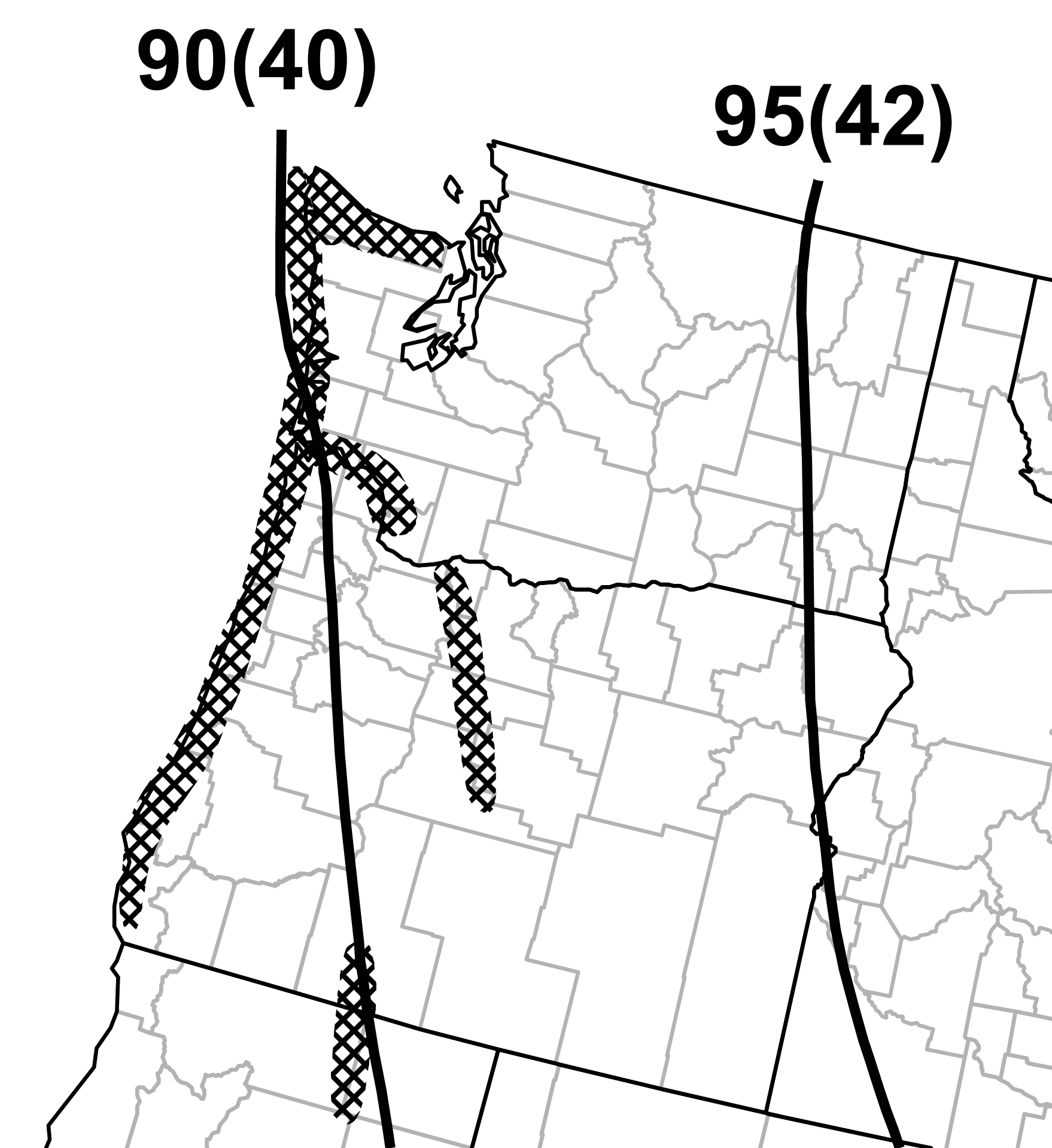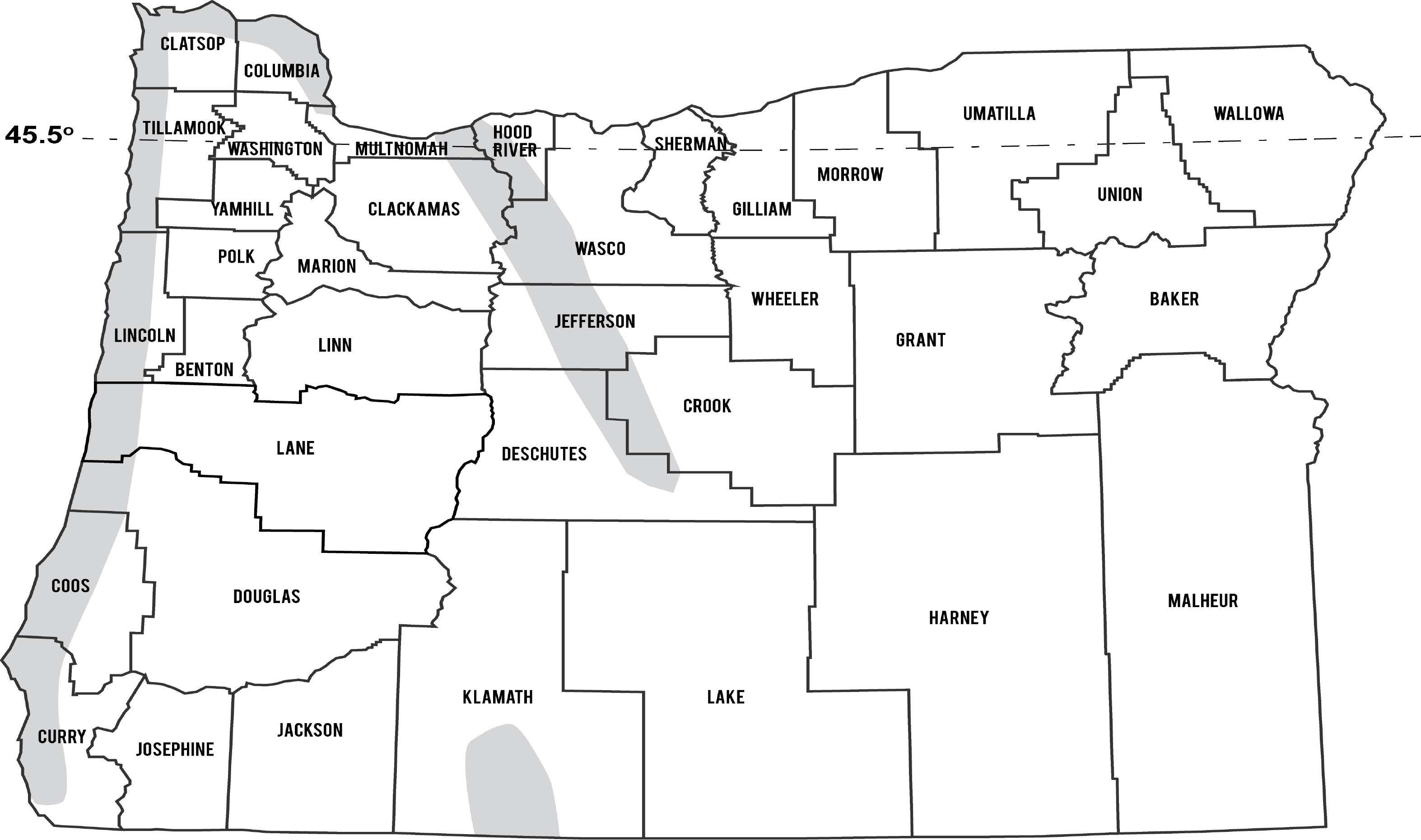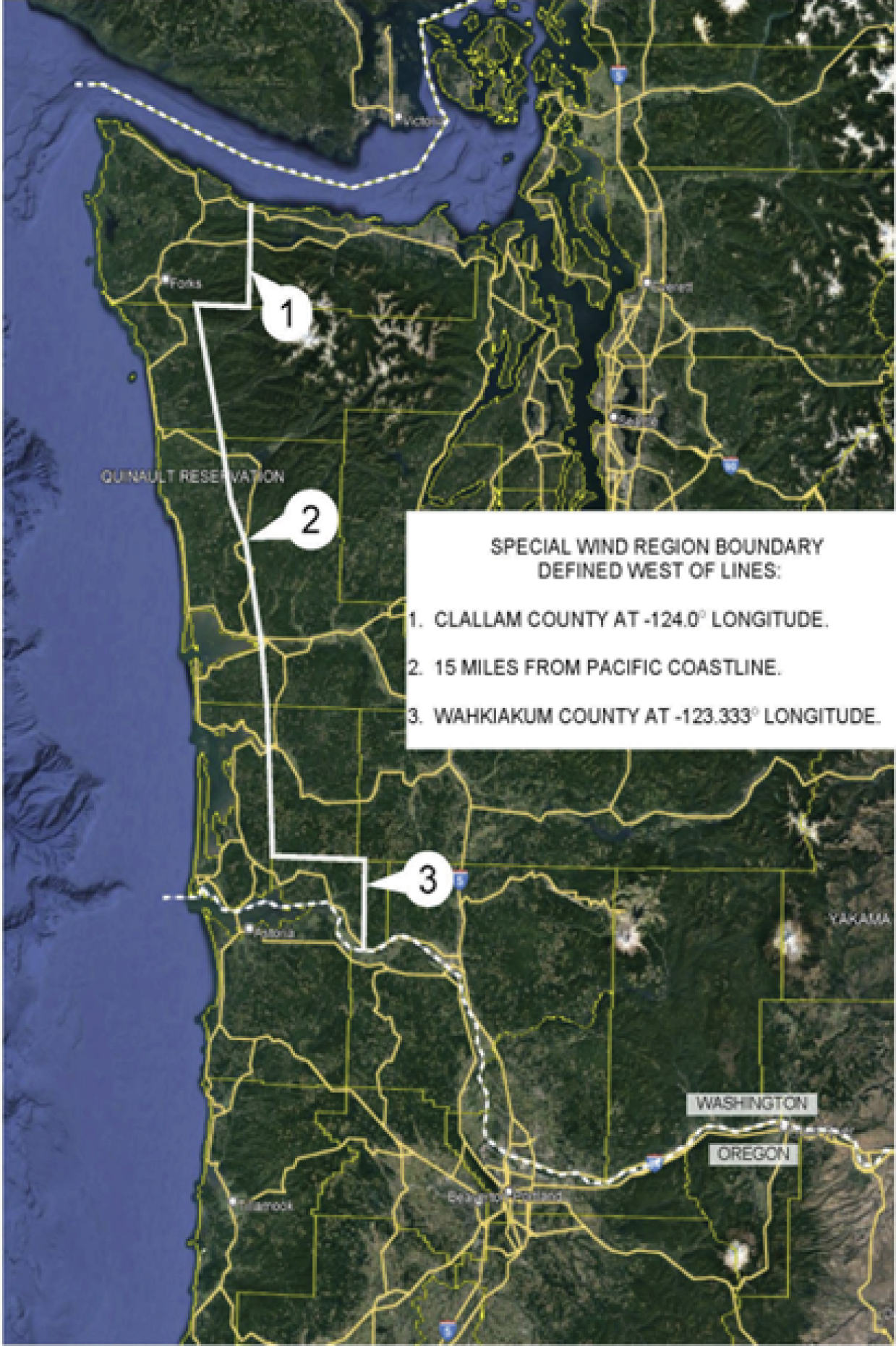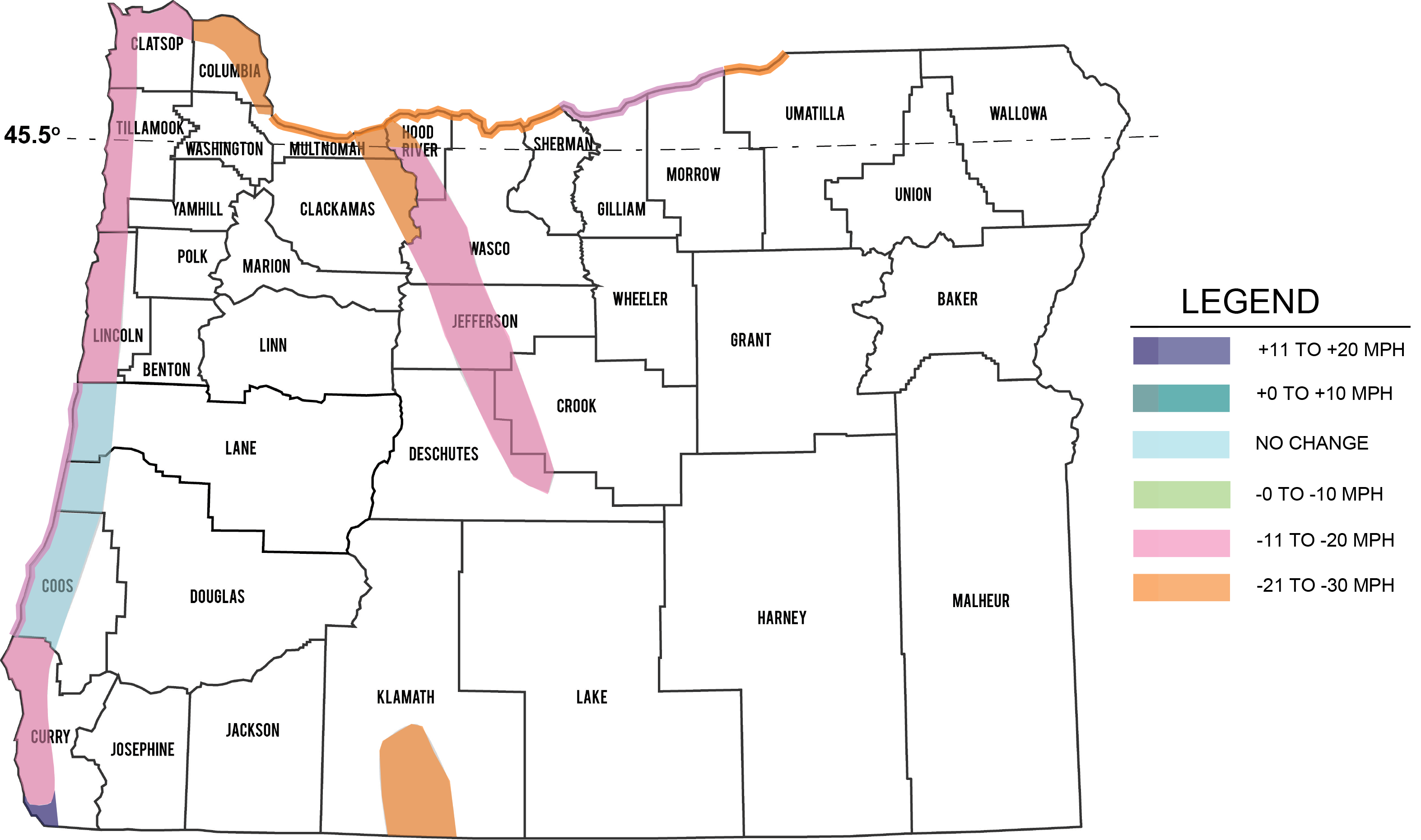By Seth Thomas
Special Wind Regions (SWR) are defined in ASCE 7-22 Section 26.5.2. as “Mountainous terrain, gorges, and special wind regions shown in Figure 26.5-1.” These regions are identified in ASCE 7 to highlight the lack of data or the high variability of wind speeds in localized areas where the wind data from the surrounding areas may not be adequate to properly capture the hazard.
The origin of special wind regions by name is from ANSI A58.1-1982 (predecessor to ASCE 7-88). The initial special wind regions were established without detailed analysis but were based on the expertise of climate/wind experts on the ANSI A58.1-1982 committee. While the extents and locations of these regions have changed somewhat, they are very similar in ASCE 7-22 to what they were in ANSI A58.1-1982.
Before ANSI A58.1-1982, the 1978 Oregon Structural Specialty Code (OSSC) specified higher wind speeds along the Oregon coast and the Columbia River Gorge, the 80-mile-long portion of the Columbia River east of Portland. It should be noted that the special wind region in the OSSC along the Columbia River Gorge never existed in ASCE 7 or the building codes on the Washington side of the river.
The commentary in ASCE 7-22 notes that the lack of climatic data along the Washington/Oregon coast as the reason for that special wind region. The Commentary further states that winds blowing over mountain ranges or through gorges or river valleys have the potential to develop speeds that are substantially higher than the maps of ASCE 7 Figure 26.5-1.
ASCE 7 Section 26.5.2 and the ASCE 7 Commentary note that the design wind speed for the special wind regions specified in ASCE 7 are to be determined by the Authority Having Jurisdiction (AHJ), based on regional knowledge and experience. In Oregon, design wind speeds are established by the state Building Codes Division and have remained static for several code cycles (same for 2007/2010/2014/2019, except for the conversion to strength level in 2014). In Washington, basic wind speeds are determined by each of the nine county AHJs with SWRs. After the significant reduction in wind speeds in ASCE 7-16 (adopted in the 2019 OSSC) wind speeds in the special wind regions for Oregon and Washington typically became 25 to 35 mph higher than those in the adjacent non-special wind region areas. This results in wind pressures that can be 50 to 90% higher. This difference comes before any exposure and topographic factors have been applied. Some of the edges of the special wind regions do occur in populated areas, thus a large step function can occur leading to significant changes in design loads at the border of these zones.
Footnote 6 of ASCE 7 Figure 26.5-1A states that site-specific values for selected special wind regions noted on the maps shall be permitted to be determined using the ASCE Wind Design Geodatabase in the ASCE Hazard tool https://asce7hazardtool.online. Site specific analyses have been performed in accordance with ASCE 7 Section 26.5.3 for northern Colorado and Kern County, California, with the results adopted in ASCE 7-22 and incorporated in the Hazard tool.


In 2018, as part of the 2019 OSSC adoption process, the Structural Engineers of Oregon (SEAO) Code Committee submitted a code change proposal to the State for the adoption of ASCE 7-16, which included the recommendation that a site-specific study be performed for the Oregon special wind regions as part of the change proposal. While Oregon agreed it was a worthwhile effort, there was no funding available, so this was dropped as part of the 2019 OSSC adoption process. SEAO’s code committee reached out to the SEA Wind committee to establish a partnership with SEAW, and a budget was established based on the estimate to complete the work in both states. This partnership was prudent from a funding standpoint, as study costs along the Columbia River, the border between Washington and Oregon, could be shared by both SEAW and SEAO. Each SEA set out to fundraise their portion of the study with the intent to finish in time for adoption in the ASCE 7-22 cycle. This goal was not met and revised to target the ASCE 7-28 cycle.
In 2022, SEAW was able to complete funding and commissioned a site-specific study for all the SWRs in Washington State, including both the Washington and Oregon sides of the Columbia River. Funding was achieved with an NCSEA grant, significant contributions from the Structural Engineers Foundation of Washington, and numerous engineering consultants and individuals. The SWR study for Washington State and the Columbia River was completed in the summer of 2022.
In the summer of 2023, SEAO finished the process of raising money, commissioning, and completing the study for the remaining SWRs in Oregon. The special wind region studies for both Washington and Oregon (performed by CPP Wind Engineering Consultants) looked at climatic data from a number of local reporting stations near existing special wind regions (typically from regional airports) and used the same methodology to establish the design wind speeds based on Risk Category as established in ASCE 7-16. Using this process, the design wind speeds were established statistically and compared to the wind speeds shown in ASCE 7 outside the special wind region.


As a result of these two studies, there are significant reductions or eliminations of the special wind regions across both states. The studies showed that the special wind regions on the east side of the Cascades in Oregon and along the Columbia River Gorge could be eliminated. The extents of the special wind regions along the north coast of the Olympic peninsula and from the mouth of the Columbia River were significantly reduced. Additionally, while the special wind region on the Pacific Coast remained, the wind speeds established by the local AHJs along the Washington and Oregon coast could be reduced. The study did show one area where the existing special wind regions did not extend far enough. In the Southwest corner of Oregon in Curry County, the study showed the special wind region should extend to the Oregon/California border (and beyond). After a review period by SEAO, Oregon’s study was finalized. The information from both studies is currently being used by SEAW and SEAO to pursue a change proposal for ASCE 7-28 to eliminate the unnecessary SWR, while mapping the wind speeds and updating the extents of the SWR that remain.
Since ASCE 7-28 will not be adopted until the 2030 IBC (2031 OSSC), the SEAO Code Committee has been working with the Oregon Building Codes Division to allow for a path of early adoption of these reduced wind speeds. On August 9th, 2023, the Oregon Building Codes Structures Board approved an interim amendment to the 2022 OSSC for the reduction in wind speeds the special wind regions shown in ASCE 7-16 matching the results of the study. The interim amendment went into effect on October 1st, 2023. The special wind regions in the Columbia River Gorge, Redmond/Bend area and Klamath falls area are all essentially eliminated by defaulting the special wind region speeds in these areas to match the adjacent area per ASCE 7-16. The special wind region at the coast will remain but most counties will see a reduction in wind speed. SEAW has authored a white paper, approved by SEAW’s State Board of Directors, and published in February 2023, recommending a similar reduction matching their study. These recommendations are being submitted by SEAW for consideration as a 2024 amendment to the Washington State Building Code.
In summary, the partnership of two-member organization to spearhead a study has led to improvements in design wind maps which will benefit the structural engineering profession. The changes would not have been possible without the outstanding efforts of the SEAO and SEAW committees, along with the generous donations by many to support their studies. SEAOC, and possibly SEAC will be joining SEAO and SEAW in submitting the results of their respective SWR site-specific study recommendations for adoption in ASCE 7-28. Much of this cooperation between these SEA Member Organizations was facilitated the NCSEA Code Advisory Wind Engineering Subcommittee. ■
Seth Thomas is an Associate at KPFF in Portland Oregon and a member of ASCE 7 Main, Flood, Tsunami, and Seismic, standard subcommittees. He can be reached at seth.thomas@kpff.com.
